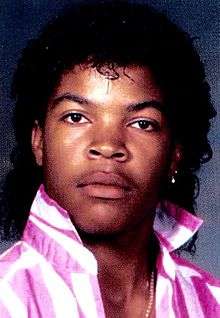Jheri curl

The Jheri curl (often spelled Jerry curl or Jeri Curl) is a permed hairstyle that was popular among African Americans during the 1980s. Invented by the hairdresser Jheri Redding,[1] the Jheri curl gave the wearer a glossy, loosely curled look. It was touted as a "wash and wear" style that was easier to care for than the other popular chemical treatment of the day, the relaxer.
A Jheri curl required a two-part application that consisted of a softener (often called a "rearranging cream") to loosen the hair and a solution to set the curls. The rearranging cream used pungent chemicals, causing the naturally tight curls to loosen and hang. The loose hair was then set and a chemical solution was then added to the hair to permanently curl it.
Perming the hair was time and labor-intensive and expensive to maintain. The harsh mix of chemicals required for the process caused the wearer's natural hair to become extremely brittle and dry.
To maintain the look of the Jheri curl, users were required to apply a curl activator spray and heavy moisturizers daily and to sleep with a plastic cap on their heads to keep the hairstyle from drying out. These products were relatively expensive (a typical bottle of activator was small, retailed anywhere from $3 to $6, and was quickly depleted). The activator in particular had the undesirable side effect of being very greasy; this would often stain clothing, furniture, and anything that came into contact with it.
Washing the hair cleansed it of the styling products but also exposed the damage done to the hair by the chemical process. Also, as the hair grew out, the wearer would be forced to return to the hair salon for a touch-up, further adding to the overall expense.
To resolve the problems associated with the cost of the look, Comer Cottrell invented a cheap kit (which he called the "Curly Kit") that could be used at home, thereby enabling ordinary African-Americans to copy the style of their wealthier idols.[2]
In media
The first Afro-American artist who sported the Jheri Curl on an album cover was Edmund Sylvers on his 1980 Casablanca release 'Have You Heard'. A trend-setting Jheri curl image was the cover of Michael Jackson's blockbuster album Thriller, which was released in 1982. Also notably, actor Samuel L. Jackson (as the character Jules Winnfield) wore a Jheri-curled wig[3] in Quentin Tarantino's Pulp Fiction. The style was also worn in the late 1980s and early 1990s by rappers DJ Quik, Eazy-E, along with other members of the hip-hop group N.W.A, such as Ice Cube.
The style has been satirized in film. Two notable examples are the Keenen Ivory Wayans character, "Jeri Curl", in the 1987 Robert Townsend film Hollywood Shuffle, and in John Landis' 1988 comedy Coming to America through Eriq La Salle's character, Darryl.[4] In the latter film, Darryl was heir to the dynasty of a fictional product named "SoulGlo", which gave the wearer a style reminiscent of a Jheri curl while at the same time leaving the infamous greasy residue on soft furnishings.
In Samuel L. Jackson's opening monologue in the 1989 film Do the Right Thing, his DJ character says that there is a "Jheri Curl alert" in effect for the day: "If you have a Jheri Curl stay in the house or you'll end up with a permanent plastic helmet on your head forever."[5]
References
- ↑ Milestones, Time, March 30, 1998.
- ↑ Grigsby Bates, Karen (11 October 2014). "Comer Cottrell, Creator Of The People's Jheri Curl, Dies At 82". NPR. Retrieved 27 September 2015.
- ↑ "Pulp Fiction (1994) - Trivia". Internet Movie Database. 2013-08-14.
- ↑ http://www.imdb.com/title/tt0093200/?ref_=ttfc_fc_tt
- ↑ "Do the Right Thing (1/10) Movie CLIP - Today's Forecast (1989) HD". YouTube. 2011-06-27. Retrieved 2016-10-09.
External links
-
 Media related to Jheri curl at Wikimedia Commons
Media related to Jheri curl at Wikimedia Commons